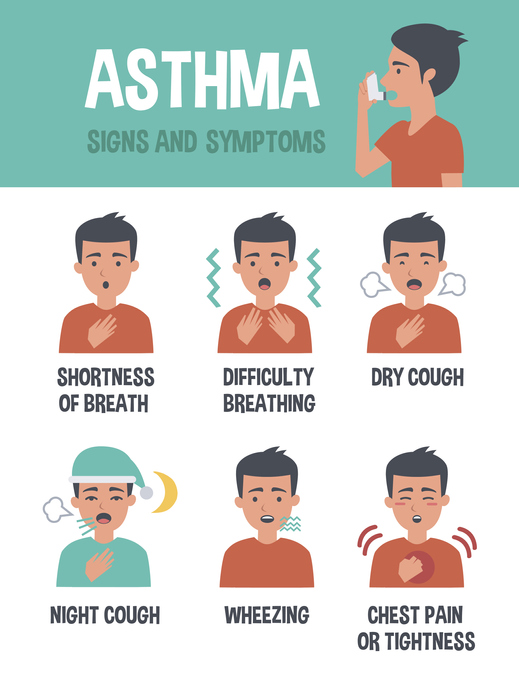If you have asthma or know someone around you with this condition, you probably have an idea that it is not fully curable. Usually, the use of an inhaler and different medications is advised to the people who have asthma as an attempt to relieve their symptoms. However, besides medication and taking precautionary measures to avoid contracting the environmental triggers of asthma, a high-fiber diet is also found beneficial. This article talks about managing asthma by focusing on fiber intake.
Understanding Asthma
Asthma is one of the lung-related diseases that are mostly long-lasting. It manifests in hindering various everyday activities of the people by posing difficulty in breathing. In some people, asthma can make climbing stairs a tough task, while in others, it can present itself in seasonal allergies triggered by various stimuli in the environment.
Asthma does not target any specific age group. It can also begin in childhood and continue through adulthood. According to News in Health, in America, approximately about 25 million people are suffering from this lung disease. As it is a lifelong condition, it is advised by medical professionals that people need to manage their asthma along with taking the prescribed medications.

How to Manage Asthma?
Understanding what causes asthma and how it affects our airways and lungs is the key to learning to manage it. Managing asthma means how to live with this condition, knowing that there is no medicine to cure it completely.
Asthma usually manifests in wheezing, chest tightness, coughing, and shortness of breath. Experts say that the root cause of all the asthma symptoms lies in the narrow airways. The tubes that help oxygen to and fro our lungs constrict due to inflammation.
This inflammation is a direct result of people with asthma contracting certain triggers in their environment, which are the cause of their symptoms. For instance, various asthmatic people are triggered by pollen, dust, animal fur, mold, or cigarette smoke.
Therefore, managing asthma implies that people susceptible to environmental triggers avoid them as much as they can. They are advised to restrict going outdoors if they are allergic to pollen. Some are advised to manage their condition by wearing a mask so that they can help ward off the pollutants triggering their asthma.
Can Fiber Help Ward Off Asthma?
Our bodily systems are all interconnected: what we eat fuels our cells and provides structure to our body. Besides energy production, food breakdown, or the process of metabolism in our body also significantly affects our respiratory system. This connection was significant enough for the professionals to start investigating how the management of our daily diet can help relieve the symptoms of asthma.
Discoveries show that there are certain food components in our diet that use up more oxygen and produce carbon dioxide as a byproduct. This condition is very harmful to people with asthma. According to a nurse practitioner at the American Lung Association, food rich in carbohydrates are claimed to aggravate asthma as they produce a large amount of carbon dioxide.

How Does Fiber Help?
Dietary fiber present in various fruits and vegetables is digested by the good gut bacteria in our intestines. This fiber is deemed very beneficial for relieving some of the pressure off of our overworking immune system. Pectin – a dietary fiber found in apples, onions, and citrus fruits – is digested by good gut bacteria and fermented into numerous fatty acids. These fatty acids are found to interact with our immune system and have a positive impact on decreasing inflammation in our body.
This positive and beneficial impact of dietary fiber is not limited to the digestive tract only. It is found that consuming a fiber-rich diet helps relieve inflammation in the whole body. Observational evidence showed that the cases of asthma shot up in the western countries during the 1960s – which is also the era when consumption of fiber was reduced in these regions.
There are many other reasons why one should consume fiber. Follow here – Top Reasons for You to Fall in Love with Fiber.
Most Influential Scientific Evidence
One of the most influential scientific pieces of evidence with regards to the link between consumption of fiber and warding off asthma is the animal research carried out by Benjamin Marsland – an immunologist. Marsland and colleagues gathered mice as research subjects. They kept the control group of mice on a low-fiber diet for about two weeks, while mice in the experimental group were given a fiber-rich diet for the same amount of time.
After two weeks, both the groups of mice were exposed to an allergen derived from dust mites, which is a significant asthma trigger in humans as well. The control group mice fed with a low-fiber diet showed more inflammation than the ones who consumed a diet packed with fiber. The mice with a low-fiber diet also showed significantly exaggerated asthma symptoms as compared to the ones fed with a low-fiber diet.
The same research also found that dietary fiber also helped decrease the levels of immune cells called eosinophils – which are usually elevated during asthma. Also, a high-fiber diet helped reduce the constriction of airways in mice. Most importantly, this research revealed that due to high fiber intake, there was a difference in the activity of the dendritic cells – the fundamental immune cells.
Usually, asthma symptoms trigger an increase in the activity of the dendritic cells, which results in the overworking of the immune system. The high-fiber diet helped tone down the turning on of these cells, which ultimately led to a balanced immune response.
Special Precautions For the Asthmatic People
Other than diet, there are a few other aspects as well which should be properly taken care of. This will be quite helpful for asthmatic people.

Avoiding Dust and Smoke
While most people are aware of the fact that asthmatic people should not get into dusty and smoky areas, sometimes, people do not follow this precaution in a precise manner. For example, asthmatic attacks can also be triggered due to fragrances as well. It can even be caused inside malls, even if they are well ventilated. This is because the malls are closed and the amount of carbon dioxide being exhaled by humans is high. The ventilation may sometimes not be enough. Therefore, people with asthma are recommended to not spend excessive time in closed spaces.
The element of smoke is higher in the case of bars and clubs. You should try to take your inhaler with you in case you are going to the club. Sometimes, the smoke could be coming indirectly as well such as from the fireworks nearby, factory smoke, candles, and other such aspects which are not usually noticeable. The reason why we insist on taking care of the indirect aspects as well is that asthma attacks can be triggered among different patients for different reasons. Therefore, something that is not easily noticeable could also be the reason why someone suffers from it.
Keep the Medication with You Always
You might hear someone saying “It’s all good, man. I have just taken my medicines so I’m good to go out without them as well”. Although when you have recently had your medicines, the chances of an asthmatic attack are low but not completely diminished. Sometimes, a lot of people have an asthmatic attack due to unknown reasons.
You might be at a place that has no smoke, dust, or other types of triggers but any unforeseen events can happen. Therefore, keeping the medication with you at all times is essentially important. Never hesitate to take your medicines in front of others as well.
Stay Warm During Winters
Winters are usually not that pollutant. This means that dust and smoke are rarely seen in the winter season. As a result of this, one has fewer chances of getting an asthmatic attack in winters. Nonetheless, there are other important factors to consider as well which may become the reason why one gets an asthmatic attack.
During winters, people face several types of problems such as blocked nose, chest congestion, flu, fever, and excessive cough as well. Such medical issues should be resolved at the earliest as they could lead to an asthmatic attack. Wear warm clothes always so that your body retains the heat. In order to humidify the air you’re breathing, use a scarf to cover your mouth and the nose. This is essential in areas where there is extreme cold and areas that have snowfall during winters. It is also advised to not exercise outdoors during the winter season.
Also, Read – Fiber Food Additive to Fight Appetite

Final Words
In addition to numerous benefits for a healthy heart, digestive system, and well-regulated bowel system, dietary fiber is also found to be relieving asthma. Acting upon the root cause of asthma, that is inflammation, fiber intake helps dampen the over-exhausted immune system, which then helps with the symptoms. This information is critical for people with asthma, as it is a life-long lung disease that can only be managed but not completely cured.
Moreover, the consumption of fats enhances the symptoms of asthma as fats and carbohydrates produce carbon dioxide when metabolized. Therefore, it is important to reduce the frequency of consuming junk foods as they are laden with fats and carbs. These foods will only aggravate the symptoms and increase discomfort.

